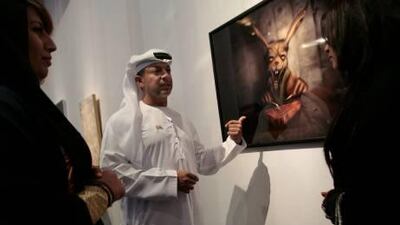WASHINGTON // Curiosity piqued, Mattar bin Lahej stopped to comment. The Emirati artist, on a tour on Thursday of the Corcoran Gallery of Art in Washington DC, pointed at a sculpture.
"Look at these materials. Here, here, and here, you see? Rust. This will fall apart in five years. That is why I don't use regular metal in my sculptures," he said.
Mr Bin Lahej was part of a delegation of 10 artists handpicked to travel to the US as part of a cultural delegation to mark the UAE's National Day.
As part of their itinerary, the artists presented their work at a Kennedy Centre reception entitled, Contemporary Reflections: UAE Heritage Through the Modern Artist's Eye.
Before that, they toured the Corcoran Gallery and took questions from students at the Corcoran College of Art and Design, students who were keen to understand the idea behind the Kennedy Centre reception, in which artists were called on to transform the words of an Emirati proverb into visual media.
Noor al Suwaidi, public programmes officer with Abu Dhabi's Tourism Development and Investment Company, which helped organize the event, said: "In the UAE, we have a lot of proverbs and poetry, things that are very intangible. The idea behind this exhibit has been to make the intangible tangible. Some of the artists chose their own poems or proverbs to depict, and some were chosen by us."
The event was arranged by the UAE embassy, which brought the ten artists to Washington and commissioned their works as part of its efforts to strengthen cultural ties between the UAE and the US and support the Emirates' art scene.
"The UAE has an increasingly vibrant arts scene, as evidenced by the emergence of local galleries and shows where Emirati artists can showcase their works. Furthermore, new branches in Abu Dhabi of the Guggenheim Museum and Louvre will establish the UAE as a world-leading destination for art,” Ambassador Yousef al Otaiba told a select gathering of dignitaries and diplomats, that included Michael Mullen, Chairman of the Joint Chiefs of Staff and Susan Rice, the US Ambassador to the United Nations.
The artists charged with this task represented the three generations of artists that have existed since Emirati independence in 1971.
Dr Najat Makki, an artist from the first generation, recalled how art had developed in the earliest days.
"When the UAE was established we sensed a new movement of fine art, and I think the first piece of fine art was the unity of the seven states of the UAE. With the founding, there was a new effort to push the citizens to all aspects of fine art."
This push has spurred the recent efforts to develop the UAE into a cultural capital. It has also posed challenges for Emirati artists.
Responding to a question from a student about a painting that depicted the Quran, which was removed from an earlier display because it was viewed as offensive to Islamic mores, Jalal Luqman explained that "somebody has to push the envelope … but with a little bit of care".
Mr Luqman is careful about the lengths to which he goes, but he has not allowed another of his paintings to be removed from an exhibition. He used his personal experience with such limitations to explain the challenges that confront the UAE as it continues to expand its arts and culture sectors.
"If we in the UAE are serious about becoming an arts and culture capital then we [have to] take the whole artistic cultural cluster, and all that comes with it," he said.
Khalid al Banna, meanwhile, talked about how excited he was to be able to take his art to America.
"We are so happy to be able to present our art in the United States. It is the country of freedom and art," he said.
But the event was more than a celebration of Emirati independence and the work of the painters, sculptors and digital media artists on display.
It was also an opportunity to expose a select global audience to Emirati heritage, and afforded the artists an opportunity to let their work reach across the boundaries of culture and place.
Ultimately, said Abdul Qadar al Rais, one of the Emirates' most senior and respected artists, art is a "unique international language that transcends borders … the Mona Lisa, while Italian, now belongs to the world. It is art's unique power to bring people from across cultures together."
Dr Makki took the point one step further when she said: "Art is the language of artists.
"In the beginning of humanity man expressed his fear, love and relationships through art. It is precisely this ability to communicate without words that is the power of the artist."
And as people began to fill the crowded reception hall, the work of each artist represented a uniquely Emirati heritage that could be shared by all.

